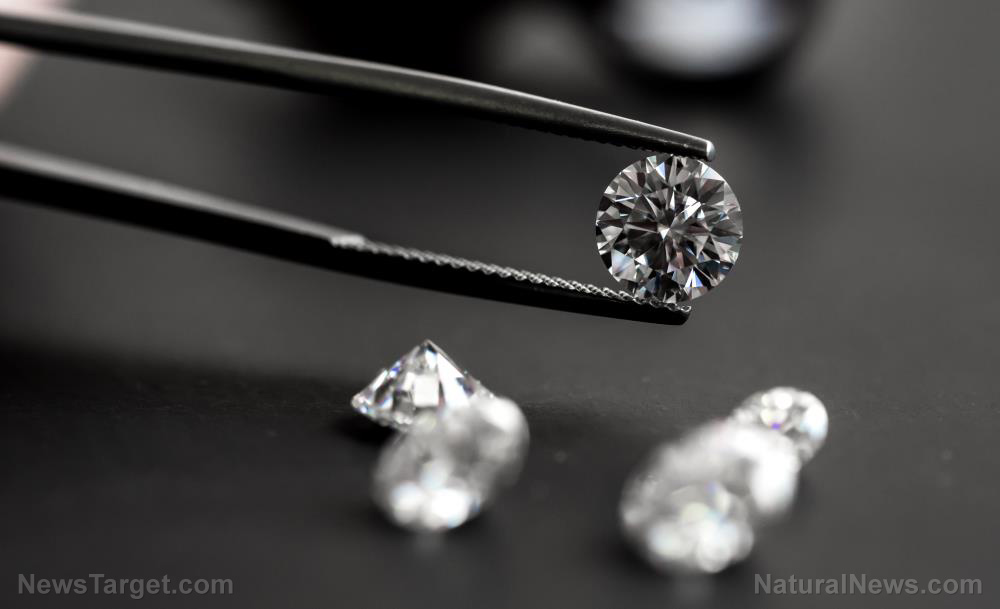
As part of their study, German and Russian researchers mimicked conditions in the mantle, the layer beneath Earth's crust where most diamonds are thought to form. By doing so, they found that diamonds grew only when exposed to an electric field.
"Our results clearly show that electric fields should be considered as an important additional factor that influences the crystallization of diamonds," Yuri Palyanov, a Russian diamond specialist and the lead researcher of the study, said in a statement.
The factors behind diamond formation
Diamonds are composed of carbon atoms arranged in a particular crystal structure. They form in high-heat, high-pressure environments more than 90 miles beneath Earth's surface. But the specific factors behind their creation remain unclear.
For their study, the researchers examined whether underground electric fields play a role in diamond formation, knowing that material in the mantle is highly conductive and that many chemical processes in it require electric energy.
The researchers built an artificial mantle in their lab and planted it with the starting ingredients necessary to produce a diamond. These included carbonate and carbonate-silicate powders that are similar to carbonate-rich mantle melts. They then subjected these ingredients to pressures of up to 7.5 gigapascals, temperatures of up to 2,900 F and electrode-powered electric fields ranging from 0.4 to one volt.
After varying periods lasting up to 40 hours, diamonds and graphite (the common low-pressure form of pure carbon) formed only when the researchers applied an electric field of about one volt and only at the cathode, the negative part of an electric field. According to the researchers, the cathode provides electrons that are necessary to trigger a chemical process. This, in turn, set off a series of reactions that transform certain carbon-oxygen compounds into carbon dioxide and, eventually, into the carbon atoms of a diamond.
The man-made diamonds were small, with diameters no bigger than 0.007 inches. But they shared many similarities with natural diamonds – both have an octahedral shape (a three-dimensional shape with eight plane faces) and small amounts of other substances, including a relatively high nitrogen content and silicate-carbonate inclusions commonly known as diamond "birthmarks" or imperfections.
Based on the result of their experiment, the researchers posit that local electrical fields play an important part in diamond formation. These electrical fields, according to the researchers, are likely produced by rock melts and fluids in the mantle with high electrical conductivity. (Related: The Earth's mantle is a "geochemically diverse mosaic," reveals team of geologists.)
"Our approach is of interest for the development of new methods for producing diamonds and other carbon materials with special properties," Palyanov said.
Extraterrestrial diamonds form via immense shock pressures
In another study, which was published last year in the journal PNAS, researchers suggest that diamonds in stony meteorites called ureilites form by rapid shock transformation from graphite, such as when minor planets collide together or with large asteroids.
Ureilites are fragments of a larger celestial body smashed to pieces through violent collisions with other celestial bodies. They often contain large quantities of carbon in the form of graphite and nanodiamonds, among other things.
Past studies suggested that diamonds in ureilites formed like those on Earth – deep in the mantle, under high continuous pressure. If diamonds in ureilites formed this way, then the original parent body on which they formed must have been a large protoplanet that was at least the size of Mars or Mercury.
But the researchers found no evidence requiring high static pressures and long growth time in a planet's deep interior. They studied diamonds from three ureilite samples and found lonsdaleite layers in the nanodiamonds, which only form under sudden, very high pressure. Moreover, the silicate minerals in the samples also displayed typical signs of shock pressure.
The researchers refuted the large parent body hypothesis and concluded that diamonds in ureilite form from original graphite via shock processes.
Learn more about cool scientific processes at Discoveries.news.
Sources include:
Please contact us for more information.























